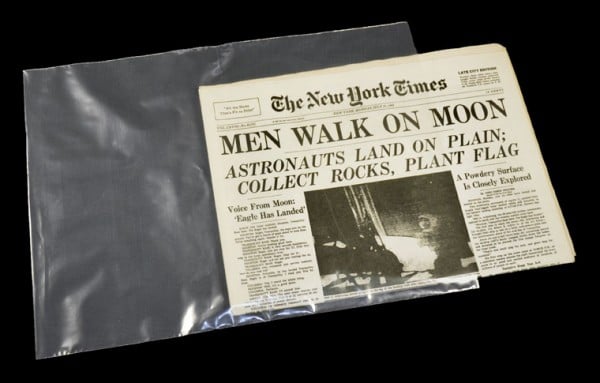While newspaper circulation has dropped off significantly in recent years, many people still save newspapers and news clippings that chronicle important events in their lives or highlight significant historical events. In addition to photographs, family ephemera often includes old newspapers and clippings of announcements such as engagements, marriages, births, and deaths.
This blog post discusses different options for storing your newspapers and clippings in archivally safe supplies and conditions.
Why Do Newspapers Break Down?
As far as collectibles go, newspapers are one of the most unstable you will find. A disposable commodity, they are produced cheaply and quickly and were not intended to last for centuries. Newsprint is made from coarse wood pulp that contains lignins and acids which cause the paper to break down over time. Newsprint yellows and becomes brittle, and the ink may fade. By following proper archival storage procedures, you can minimize potential damage and prolong the life of these fragile artifacts.
Display a Copy, Not the Original Newsprint
If you would like to display an important or sentimental newspaper or clipping in a picture frame, don’t use the original. Even behind glass, this irreplaceable artifact isn’t safe. Ultraviolet (UV) light, a component of sunlight and some artificial light sources, is extremely damaging to almost all artifacts. Newsprint is especially sensitive to the damaging effects of UV light.
Either scan and print your clipping or newspaper page, or make a color photocopy of it to preserve the tonalities of the original. Frame your reproduction using high quality archival matboard, framing supplies, and UV-filtering glass or acrylic (such as Plexiglas). Check out our framing supplies or work with a reputable frame shop in your area.
If we can’t dissuade you from framing your original, it should only be exposed to incandescent light (no fluorescent light and no direct sunlight), and matted with high-quality, acid-free materials and UV-filtering glass or acrylic.
Getting Started: First Steps for Archival Storage
When working on an archival storage project, always wash and dry hands thoroughly before handling your artifacts, and have a clean work surface away from food, beverages, and curious pets. Gloves (we prefer nitrile, but white cotton are also an option) can be worn for added protection but they aren’t appropriate for every task. When dealing with papers, clean, dry hands are the best option.

Please be sure to carefully remove any paper clips or staples from old newspaper clippings before you place them in archival enclosures.
If you have the storage space and access to a box large enough, newspapers are ideally stored flat. The paper fibers stress and break at the folds first. If you can’t unfold entirely, storing with the one fold in half is acceptable. Clippings, too, should be unfolded as much as possible.
Storing Whole Newspapers
Archival newspaper storage begins with a double layer of protection using archival polyethylene bags and buffered, acid-free boxes. These bags and boxes minimize “acid migration” from one newspaper to another, keep out dust, moisture and pollutants, and keep your newspapers and clippings in a dark, dry environment. Our Newspaper Storage Kit, available in several sizes, includes an acid-free, metal-edge drop front box, a reusable desiccant canister to remove harmful moisture, and ten polyethylene bags to hold individual newspapers.
Storing Newspaper Clippings
When storing smaller newspaper clippings you have several options. Crystal Clear Bags or Side Loading Print Sleeves with Card Stock Inserts work well. The acid-free card stock provides support and rigidity, and a place to add relevant information in pencil. Use the card stock to write notes about what paper the article came from, the date, and why you saved it. A clear plastic enclosure allows you to view the clipping without handling the fragile newsprint.
Once housed in this type of enclosure, you can select an appropriately sized archival box to hold your clippings or a collection of clippings and similarly sized or related ephemera. A Drop Front Box is a flat storage solution and comes in a wide range of sizes.
Another appropriate box would be a Document Box in conjunction with Archival File Folders. If you don’t fill the box, use Document Box Spacers to take up extra space so the folders and objects don’t slump.
An Archival Binder can also be used to safely store your clippings using Archival Print Pages with Card Stock Inserts or 3-Ring Page Protectors.
Proper Storage Conditions
Once a newspaper or clipping is safely inside an archival polyethylene bag or polyester sleeve, and an acid-free box or archival binder, you need to find an appropriate place to store it. A dry, dark environment such as a closet in your living space is a good option. Never store items you are trying to preserve in a garage, basement, or attic. The temperature and humidity fluctuations in these spaces is not good for long-term storage. These areas of a home are also more prone to leaks and flooding which could harm your collections.
Consult a Conservator
Newspapers will eventually deteriorate over time due to their acid and lignin content. Proper archival storage only slows down this process. If needed, consult a professional paper conservator who can neutralize these harmful chemicals through a process known as deacidification, Note that this can only stop current damage, and not reverse any yellowing or brittleness that has already occurred.






